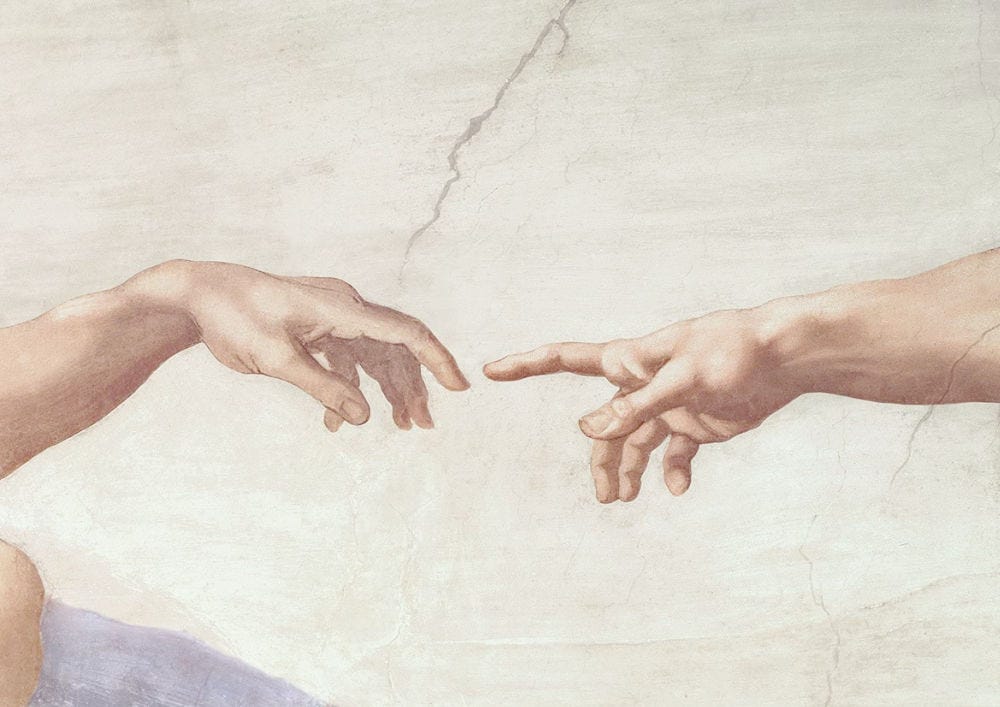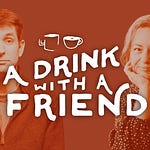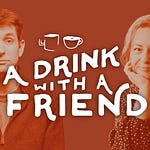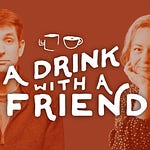Dostoevsky said it will change the world. Confucius said everything has it, but not everyone sees it. Shakespeare, Plato, and others wondered if it was in the eye of the beholder. Beauty matters in our everyday lives; it’s not an extra “nice to have.” But where do we find it? What do we do with it? How does it affect our ordinary lives? And is it subjective or objective?
Seth: Website | Newsletter | Twitter | Instagram
Tsh: Website | Newsletter | Twitter | Instagram
“Bad Art Warps Our Vision“, by Leah Libresco Sargeant
Sympathetic Magic, by Typhoon
Scroll down for the transcript.
Seth: This is A Drink with a Friend, I’m Seth Haines.
Tsh: And I’m Tsh Oxenreider. Hi, Tate.
Tate: Hi.
Tsh: This is my daughter, Tatum. She’s almost sixteen years old. Tate, do you think beauty is objective or subjective?
Tate: I think beauty should be seen as more subjective but I feel like in our modern-day it ends up being objective. Objective is more like what a singular person thinks it should be and then subjective is how it makes you feel. I think it’s a little bit of both. I just think you shouldn’t judge others in what they think is objective or subjective.
Tsh: Do you think, if what I’m hearing you say is subjective beauty has to do with how it makes you feel so it has to do with a response of the person?
Tate: Yeah. If someone thinks that, I don’t know, chickens are beautiful because of their appearance, they shouldn’t be judged by that. I think blankets are beautiful but they don’t look pretty, no, but they make me feel comfortable. They make me feel safe. I find beauty in safety and comfort.
Tsh: That’s not just a visual thing?
Tate: Yeah. It depends on how you define beauty.
Tsh: Can someone look at something and say, “That is objectively beautiful,” meaning we should all agree that that falls under the definition of something beautiful, like a mountain or a sunset?
Tate: Yeah, there are definitely things like that. I think sunsets are beautiful, they’re not the most beautiful thing to me. It really just depends on the person.
Tsh: If somebody says sunsets are not beautiful, are they wrong?
Tate: No. Because that is their opinion.
Tsh: So you think beauty is subjective, then?
Tate: Yes.
Tsh: Okay. Thanks, appreciate it.
Tate: Uh-huh.
Seth: Tsh, what are you drinking today?
Tsh: I am drinking tea because it’s late afternoon and I need the little burst of energy. It is called Pride and Peppermint, which is super dumb but I thought it’s sorta cheeky for our conversation today. It was sent to me, I say it’s kinda dumb and now I’m going to say, it was sent to me by a reader. Reader, it is not dumb at all! It is lovely. Ever since I started leading Literary London, people have occasionally sent London-esque adjacent things. Somebody sent me this little bag of tea and it’s rooibos, peppermint, and chamomile. It’s lovely. It’s loose leaf tea. I like it. It’s good for the afternoons.
Seth: Speaking of London and you again, being an Anglophile as we always talk about on this show. Did you check out Anglophenia yet?
Tsh: I did. It is so fun!
Seth: It is fun, isn’t it?
Tsh: It is a bit of a rabbit hole, though. I had to stop myself, which is true of all YouTube.
Seth: It’s that way with all things, though English for you.
Tsh: Yes, it’s very fun. Alright, so what are you drinking today?
Seth: I am drinking, again, coffee. This is a new roast from my people at Onyx Coffee Labs. I don’t really remember the name of it, I meant to look before I came in here to record and I completely forgot. It is some type of weird blend. You get the Ethiopian berry-ish note, the East African berry-ish notes, but also it has a lot of Earth to it and a lot of chocolate. It’s really nice. I think I would drink this every day if I could.
Tsh: Nice, very cool. I love that you bring it up so often because to me, it’s a staple drink that I, black coffee, that’s several times a day.
Seth: We normally record this in the afternoon and by the afternoons, I’m pretty much done. I kind of need that jolt and so this is my jolt today.
Tsh: Very cool. I love it. We talked about today’s topic because this is early on in our show and we want to get some fundamentals, not out of the way, but really solidified. We talk all the time about truth, goodness, and beauty as the three transcendentals in our worldview, with beauty being important to both of us these days. I would love for you to start us off talking about what that even means to you because that’s such a loosey-goosey term that can mean a lot of things to a lot of people.
Seth: First, it probably bears mentioning what when we talk about things like beauty, truth, and goodness, these aren’t our unique rubric for viewing the world.
Tsh: Right, we didn’t come up with this.
Seth: We did not come up with this. This has been around for a really long time associated with the ancient Greeks. This is a rubric that’s been run for a long time and it’s been run in faith circles for a long time also. And in both of the faith traditions that we are in/exploring you see this come up. Truth, beauty, and goodness come up over and over again. For me, when I think of beauty, we actually had a brief conversation that I’m looking forward to getting into about whether or not beauty is objective or subjective, but when I think of beauty, let’s spend a minute thinking about the objective beauties of the world. When I think of beauty, I think of the transcendent sunrise. I think of the hills of Tuscany when the sun is setting. There’s an objective beauty there. When you look at it, you can’t help but say holy-moly, that’s amazing. This weekend, I was actually fishing on the river with my son and there was this brief moment where I heard the chittering of a kingfisher and it was over my shoulder, I couldn’t see it. I looked at him and I said, kingfisher, and turned around right in time to see the kingfisher dive down into the water. It was this moment of actual transcendent beauty. When I think of beauty, the first thing I think of are those created things that just capture your attention, enrapture you, that moves something inside of you that make you look at the world and say, wow, this is amazing. It’s amazing to be alive because life is so beautiful.
Tsh: Yeah. It’s one of these things that to me, is the core to what we’re even doing here. Because if this whole show, if this whole epic conversation we’re having is about the idea of sacramentality, sacramentality is really about the things that tap into the divine. It’s about peeling back the layer to see what’s really there and whenever we can’t explain it, I think that’s almost like a trail to follow. That sounds like an excuse to not be able to accurately define beauty, but to me, that’s a little bit of what beauty is, it’s the unexplainable, it’s the mystery that we can all somehow know it’s there without being able to put our finger on it, in a way.
Seth: Yeah. I think that’s true. I think there are some things are subjectively beautiful. There are some things that we look at and that some of us would look at and say, oh, that’s beautiful, and others would say, no that’s not really my taste or my liking. Again, I think we’ll talk about that, but there is something that we can all find some common ground in certain kinds of beauty. To me, that’s the kind of stuff that’s really moving and unifying and brings all of humanity together. I know that sounds like I’d like to buy the world a Coke and teach it how to sing, but that’s not really what I’m saying. I’m not trying to create some idealized picture other than to say there are just certain things that we can all connect with because of the sheer beauty of them.
Tsh: Right. I think that actually gets to what we’re saying, it’s more than just I’d like to buy the world a Coke. There’s actually something to be said about why beauty matters as much as it does because it’s more than that. It’s actually essential. It’s not an extra would-be-nice if that was around. I think it’s easy to brush it off as an extra thing. It would be nice if my backyard was beautifully landscaped but it’s not, so oh well. Whenever we think of beauty that way, it goes to show how shallow we’re really thinking when we are trying to define beauty because that’s not it. You can find beauty in the deepest slums in the poorest of poor places in the world. It’s more than just surface-level what-is-eye-catching. I think that’s why it’s important to think about the fact that it’s whether it’s objective or subjective. This is a question I’ve actually brought up with my students some. I brought it up a couple of months ago when we were reading Dante’s Inferno. Dante talks about beauty as being one of the most important parts of life. He gets into that in Purgatorio. I asked the students, is beauty objective or subjective? Of course, they all, 100% said subjective. Beauty is subjective. Beauty is in the eye of the beholder. I don’t know who said that? Is that a Shakespeare thing, or what? We all know that saying and yet it’s a relatively new idea. In the span of human history, the idea of beauty being subjective is not that old. That these Greek philosophers had the idea that beauty is objective, both Plato and Aristotle argued that it’s objective.
Seth: Yeah.
Tsh: I think that’s fascinating, it makes me wonder how much of what we think of when we think of beauty has to do with our modern idea post-enlightenment. How does it make me feel? How do I interpret it instead of it’s actually not about me, at all, the concept of beauty?
Seth: Like an individualistic expression versus or interpretive expression versus a collective expression?
Tsh: Exactly.
Seth: You raise something that I think is good. You said even in the darkest slums of the world you can still find beauty and you have traveled a lot. You have been to some of the most majestic places. You have been to places where there was deep poverty. You have been all over. Here’s my question for you, I guess. Have you been to a place where you were surprised by the beauty you found? What’s an example of that? What’s a story that shows how you can find beauty in the darkest or the most impoverished or even the most unlikely place?
Tsh: When we were on our big trip, we went to Ethiopia for a long weekend. I know you’ve been to Ethiopia, too.
Seth: Yeah, love it.
Tsh: To me that’s a place of haunting beauty because the landscape is surreal. It’s so high in elevation, the air is so dry. Our kids, one threw up. I think two got nose bleeds, something like that. We all got dehydrated because it’s surprisingly high in elevation. We went through these, I want to say, a day and a half of travel to get to this village. We were going to visit a family. We sponsor a couple of kids with Compassion International. We were visiting one of our kiddos. I knew that his mom was a single mom and I knew that she had a couple of more kids than the one kid we were supporting. We tend to pick the kids roughly our same kids age, just for some connection/meaning for our own kids. When we finally got to their home, and this was after several days of getting there, and this has happened to us before because Kyle and I met in Kosovo in a pretty war-torn, tiny little village in the middle of nowhere. This was not our first rodeo when it comes to interacting with poverty in a cross-cultural context. It still stopped me in my tracks how they quite literally killed the fatted calf, it was a goat, but it was the same idea, for our family’s visit. The fact that they all pulled their resources to provide this feast for us. I don’t know if anyone else has had Ethiopian food, it’s not very Western.
Seth: At all.
Tsh: At all. I knew that our kids, this was a theme in our whole trip was, just try it. If you don’t love it, we’ll get pizza next week, it’s okay. That was our bribery with the kids, you can get pizza all over the world. If they needed to try injera, that weird Ethiopian bread, we’ll get pizza next week. It was that kind of feast, where it’s all on a big plate and we all eat with our hands, there’s no separate anything. We just eat communally. To me, it was one of the most sacred, simple forms of beauty I had yet witnessed in a long time because we were on a dusty dirt floor in the middle of nowhere and yet, we had a feast! There was the whole coffee ceremony, I don’t know if you’ve ever had that in Ethiopia?
Seth: Yes, it is amazing.
Tsh: It was amazing. It was hours of this ceremonial feast just because we were visitors. When you read stuff like ancient texts, I’m thinking in particular, the Bible, but other things too, those of us in the modern Western world, we’ve divorced the idea of what it means to welcome a guest. It’s just not the same, except some of these cultures still really embody that and to me that was one of the most beautiful things I’d ever seen because we didn’t deserve it. We were there to bless them, I’m doing air quotes, and they went above and beyond because were visiting them. It was an honor to welcome someone in their home and it reminded me of when we lived in Turkey, that was the mindset, that is the mindset of hospitality. When somebody comes to your home, it is a great honor. To surprise somebody with a spontaneous knock on the door, it’s an honor. Whereas here in the US, it’s the opposite, what are you doing? Just the idea of beauty being in relationship is something that I still need to learn a lot about. How about you? You’ve done some traveling too, but even here in the States, there’s all sorts of hidden beauty in surprising places. Is there one in your life?
Seth: I really like the way you’re talking about beauty as being not just art or not just creation, nature. It’s something that’s other. Beauty can be found in relational sharing. We definitely experience that on a regular basis here. We have a couple of friends, one’s named Ashlan, the other’s name is Angela. They’re both amazing cooks. When you go to Angela’s house, she will pull out all the stops and create the most beautiful dishes. Whether it’s a simple chicken dish or something a little bit more complex, there’s always a variety of colors, the plating is always done to appeal to all of your senses, not just taste. It’s also meant to be appealing visually. She does such a good job from a hospitality perspective of making sure that it’s all done with great beauty. It’s so fun as a result. It’s great. Which makes me think the last time we went to dinner, Amber and I went to dinner with Angela and her husband. We went to a restaurant called Atlas, it’s here in Fayetteville. We sat down and had the most exquisite platings of food, not because somehow the food, the food was extremely good, but just the presentation of it was so beautiful and artistically done that you could look at it and say, objectively, that is beautiful. You have paired things that should not be paired together. You’ve made a colorful presentation. It tastes amazing. The conversation is good. Everything about this moment is beautiful. I really resonate with your thought of hospitality and food as being a medium for beauty. But then I’ll just tell you, we live in one of the best art communities in the world.
Tsh: Yeah you do, actually.
Seth: People are always blown away when I say that and they always joke around, oh yeah, great art. Well, we have Crystal Bridges, the Museum of American Art. It is amazing. It’s curated by Alice Walton and her people. You can imagine the amount of time and effort and money and controversy to some degree that has gone in to curating the museum. The museum is absolutely astounding. The pieces that you’ve seen your whole life growing up are there. There’s a Rothko there that I love. Rothko, some would say, perhaps is not objectively beautiful. It’s colored squares or whatever people want to characterize it as. But if you go and you sit in front of this Rothko, and you just take some time to contemplate it and you begin to look at the colors and you get to see the micro-variations in color across the wash of this orange square, you begin to see something that’s really a lot more nuanced than an orange square. It is a beautiful painting when you go look at it and you say, I couldn’t actually do that. It’s not just an orange square. There’s something about it that is really moving. If you take the time to take in the beauty and to recognize it for what it is, which was to some degree, a portal into his own personal creativity. It’s an invitation to look at his personal creativity and say, what can I learn from this? What can I take away from this? That’s just one piece, there are so many amazing pieces in that museum. We’ve been blessed to get that take of beauty just from so many different angles. From the Ozark Mountains to the food that Angela makes to this amazing museum at Crystal Bridges. We are surrounded by beauty in northwest Arkansas.
Tsh: To me, the example of the Rothko speaks back to the ancient Greek idea of beauty being objective. Plato defined, well, he has said that beauty resides in the domain of forms. Aristotle talked about how beauty resides in what can be defined, like characteristics such as symmetry, order, balance, proportion, things like that. I think this speaks into why there’s a difference between beauty and taste. You can objectively see that the Rothko is beautiful, even if it’s not your “taste”. I can listen to a Puccini opera and though opera is perhaps not my favorite form of music, I can still acknowledge that it is beautiful. I could even acknowledge that perhaps it is more beautiful than certain forms of modern music. If we’re going to actually call something more or less beautiful, even if it’s not something I’m going to necessarily queue up on my Spotify account. There is a difference between acknowledging beauty and enjoying it perhaps. I don’t know. I’m still working through this a little bit. I mentioned before we hit record that I took a six-week class this past summer on beauty just for fun. It was a six-week class and each of the six weeks went through a different time period exploring what did these people think of beauty and what was their definition of beauty. It went chronologically. We started with ancient Greece and we went all the way to the modern, 20th century. It was interesting to see the subtle shift in objective to subjective. In the Roman view, this is like week two after the Greeks, there was a connection between beauty and morality. This idea that those who are objectively beautiful on the outside are actually more noble and so that’s why they would value things like good form in a human body, all the naked statues but also the beauty of goddesses and gods and how they would paint something immoral as “ugly” like Medusa. I know that’s Greece, too. Or see this beautiful symmetrical form of a human body and declare that they are good or noble. While we think in our 21st-century idea that that’s not necessarily a correlation, it’s interesting to me that that is an ancient idea that’s embedded in our psyche. It makes me wonder where have we come up with that concept that there is a connection between beauty and goodness? I think that’s fascinating.
Seth: Part of what you’re saying, too, when you talk about the moral good of beauty and the way that beauty was used to show a moral good and how that’s actually been decoupled. We actually see that playing out in the real world architecture of the day. I think back to that moment when we were in the beautiful church in Florence and really I think of the cathedral in Sienna, is another example of that. Where you just walk in and your breath just leaves you because it is so beautiful. You don’t have to go to Europe to see these things. You can go to the oldest church in your hometown and you’ll probably get a chance to see the same kind of idea of we’re going to actually invest in art. We’re going to invest in beauty. Beauty has a transcendent character. It draws the eyes and the heart upward. It does have a moral characteristic to it. When you go to these old churches, whether it’s in Fayetteville, Arkansas or Austin, Texas or Los Angeles, or it doesn’t matter where you go. You go to these older churches and you begin to see some of this amazing beauty. In fact, last night I texted a friend who grew up in Baton Rouge and there was this amazing pieta that was painted in a church in Baton Rouge and the pieta is in the front, and on the left panel is a soldier. It was painted around World War II time, and there was a soldier on the left panel and on the right panel was his wife and his child, I think, or his children. It was this existential rendering of the suffering of humankind being bridged by the suffering of Mary. I’m sure there are layers to the interpretation of that piece but it’s in a church in Baton Rouge. I don’t remember the artist, but I’ll definitely send you a link so you can put it in the show notes. You look at that on the one hand and then, on the other hand, you look at the modern expression of church, this is not in all cases, this is not all true. There are churches of all denominations that do beauty very, very well. You look at the classic example of the strip mall church. The white box with the beauty being generated by can lights. Again, no judgment there but it is just a different way of looking at the worship experience. It’s saying, we can manufacture the beauty versus we’re going to create this timeless, time tested, longstanding act of beauty that’s going to last forever. No Gap for Kids is going to move into this space and tear it apart. I think that there really is something to be said for longstanding, long-lasting artistic expressions that are sacred and that draw the eyes and the heart up.
Tsh: I don’t know what your experience has been but growing up, I honestly looked at some of those high church cathedrals and gilded art and architecture and I almost thought the opposite of what I do now which is why would you spend all that time and money on something that’s going to “burn”? This idea that this isn’t eternal and so why does it matter? I grew up with this idea of church isn’t a building, it’s a people. There was this utilitarian mindset of who cares what church looks like? Make it a warehouse. I have since come to think otherwise. You almost can’t not think otherwise when you’re standing in one of those cathedrals, not to say we all have the same experience. I find it fascinating that it just might have a lot to do with our worldview growing up and what we’ve come to experience in reality that perhaps there is something practical to creating a cathedral that literally take generations to build. Several hundred years in the case of some of these places in Europe and elsewhere that are really, really old, that they matter and they’re not just extra for the sake of showing off or look what we can do. I think it’s fascinating that up until not that long ago that most of the art came from the Church, capital C. I think that’s fascinating.
Seth: Two years ago, I had an opportunity to talk with, walk around with, and view the private gallery of a woman named Roberta Amenson (sp?). That name is probably not going to ring a bell for a lot of people but she has really patroned a lot of art. She has some Fujimura in her collection. She has amazing pieces. I happened to be in her neck of the woods and ended up at her warehouse and we were looking at all this beautiful art. She made a comment that was really interesting. She said, there were years and years where I looked at particularly religious art the way you just described like it’s all going to burn. She said but then I came to understand that the Catholic Church actually was creating a place where the person could get a taste of heaven on Sunday. They could come in and they could see the art and they could see the high walls and they could hear the music and they could engage in the senses and smell the incense and all these things in a way that would stir the soul towards beauty and that that would become their way of saying, okay, I’ve a taste of heaven. Now I’m going to go out about my week and then I’m going to come back next week and I’m going to get to walk into the gates of heaven again. There was something about that comment that always just stuck out to me as being one, it was just a really humble way to look at it instead of a high-minded judgmental way. It was a really humble way to look at it. Maybe we haven’t pegged this all, right? Maybe there is another way to look at the beauty of the church in a way that is respectful and respects the tradition? The other thing it did for me is just open my eyes to the fact that we actually need to spend time understanding that sacred art isn’t just art. That it is actually sacred. It reminds us that we are not alone, that there is something that is beautiful and good and transcendent. It points us upwards. It moves us upwards, and really it should if contemplated, take us out of the contemplation of the world. It should give us the relief, so to speak. When I go to a really great museum or when I go to a really great cathedral, the feeling is the same. The feeling is relief. There’s something innately good about that for the human soul, I think.
Tsh: I’m glad you said that because the other step to me is there’s something innately good and there’s something innately true about it. I know I’ve talked about this piece already, but I’m going to bring it up again. Leah Libresco wrote this fantastic essay about art and how bad art is objective, in the same way that good art is beautiful and therefore objective. The reason bad art is bad art is because it’s untrue. She makes the case that things like pornography is bad art because it actually distorts the nature of what’s really there. It’s not real. In fact, this quote I love, she says, well, I should say she is referring to the song that came out last summer that is very well known and also very ummmm not kid-friendly. What she says about it is,
“We should object to prurient songs and stories not because they made our cultural landscape too narrow, but because they are fundamentally untruthful—and thus bad art.”
To me, that’s what speaks to that thing that we can’t quite pinpoint that I was talking about at the top of the show, why we can’t name it really is because it is true in the midst of our messy world. We can look at a wildflower blooming along an ugly interstate and we can look at that and say that’s more true than this ugly concrete highway. It catches in your throat for a split-second before you get back to focusing on the traffic because it speaks to something truer than we realize.
Seth: That is true. There is something fundamentally different about the flower. There’s a different quality about the flower than there is about a really well designed and engineered highway. It’s saying the highway is not amazing or that it didn’t take talent to do, there is just something fundamentally and characteristically different about the flower. I go back to the song that you’re referencing, it’s not to say that there wasn’t some creativity in the song. It’s not to say that engineers didn’t work really hard to create a catchy tune and that there wasn’t some human creativity and ingenuity in putting the lyrics together. There is something to say, is that the way that we need to be using our human creativity? Is it the best use of our human creativity and when we look at it, can we say objectively that was a good and true use of our human creativity? That sounds awfully judgmental, doesn’t it?
Tsh: I know what you mean and I think a lot of listeners probably know what you mean. Those of us that grew up in the 80s and 90s, we remember the Soviet Union and this idea of the Communist Bloc. I don’t know about you but I remember looking at pictures and later I went to the Soviet Union when I was 15 in the early 90s, right after the Iron Curtain fell and I would look at these buildings that are just concrete slabs and we would say, that is objectively ugly. I get that there is something about taste. I get it. But we could see the utilitarianism in it and recognize that that was not made with beauty in mind. That’s not to get into all the weird politics of things, that’s not what this is about. It’s about the fundamental why and the reason we make things as people. If we are made in the image of our Creator, part of what makes us truly made in that image is our ability to create. We can create astounding beauty but that doesn’t mean everything we make is beautiful.
Seth: That leads me to this. We were talking beforehand a little bit about some of the things that we love about the catechism of the Catholic Church. First of all, it covers every topic. Whether or not it covers every topic to my liking is probably a whole other podcast that we could do. But it does say some things about art and one of the things that we find in the catechism, and this is the not laymen’s expression of it, but it reads,
“Indeed, art is a distinctively human form of expression; beyond the search for the necessities of life which is common to all living creatures, art is a freely given superabundance of the human being's inner riches. Arising from talent given by the Creator and from man's own effort, art is a form of practical wisdom, uniting knowledge and skill, to give form to the truth of reality in a language accessible to sight or hearing.”
Essentially what it’s saying is art is a way to draw your mind from the things of earth to something that is transcendent to the grace of God, the goodness of God. What is created by him and is beautiful by him. He’s given us a little piece of that. I think that goes to exactly what you’re saying. When you look at the products of Russian architecture of old, it’s gorgeous. It is objectively beautiful.
Tsh: Right.
Seth: You can say, in a sense, that that is God’s gift of creativity to some human in Russia to create this architectural marvel. But then there’s other piece of utilitarian Soviet Bloc architecture that’s just concrete bloc buildings. Again, it’s not saying that that isn’t in a sense creative, but it doesn’t display that superabundance that’s reference. It’s not like we’re using all of our faculties to draw our eyes up to something bigger and grander.
Tsh: I think it’s where in the catechism where it says art is a form of practical wisdom. Perhaps that is what is meant by good art or when something created is actually art is when it is wise? When it’s practically wise? When it actually teaches more about the divine, more about what’s really there? You know? We live on a town square, a historic town square that’s routinely voted the most beautiful town square in Texas again and again and everyone likes to tell you that because there’s little signs all over the town square. What’s funny to me is, we’ve got buildings from the 1800s that are still, they look the way they did. But then we’ll have this ugly bank from the early 1960s that is a beige square right on the town square and it just looks entirely out of place. I think of that. I think of it really looks like, oh, we need a bank, let’s slop something there. What is the cheapest way we can pour concrete and turn the lights on so that we have a bank? That’s the feel I get to it. That’s not to say when there aren’t times and places when that’s a necessity. There’s something to be said about even those practical things needing to point to the transcendent.
Seth: To make it completely practical we’re not even just saying that this is about sacred or non-sacred. There are very non-sacred paintings or pieces that were not made for religious purposes that still are very beautiful and tell deep human truths and those things are transcendent and beautiful. Also, I think of, do you know the painting The Third of May by Goya?
Tsh: I don’t. But go ahead.
Seth: It’s the painting of the revolution and the man is before the firing squad and he’s got his arms outstretched and it is a vicious painting. But it is beautiful and it tells a really human truth of the death of innocence at the power of others. There’s something about that that’s transcendent and beautiful and helps us understand ourselves better and helps us understand the world around us better. Those things are beautiful, that’s beauty. It can help us understand really who we are in the universe and who God is in relation to us even though it’s not meant as a piece of sacred art. That is fundamentally different than the square block bank building with an ATM machine outside of it.
Tsh: It reminds me a little bit of the catechism that we read at the beginning of my English classes. I know I’ve already talked about this before on the show. The first two questions that I ask the kids, rote memory, the first one is, “Why do we read great literature?” They answer, “Great literature exposes us to truth, goodness, and beauty. Deepens our intellect and cultivates our poetic knowledge.” My next question is, “What is poetic knowledge?” The answer is, “Poetic knowledge is the intuitive knowledge of the nature of things, when our mind and emotions see in delight or terror the significance of what is really there.”
Seth: Oh, wow.
Tsh: To me, that’s what paintings like that do. It’s not beautiful in the sense of its flowers in a field or a sunny day or a baby. Something terrible also has a sense of beauty to it because it’s showing what’s really there. It leads those of us who were there to witness it, be it a story or a painting or a song, to more intuitively know the nature of things, the real nature of things.
Seth: To me, that’s what it’s all about. I love a good song, a good painting, a good meal, a good piece of architecture, a good photograph. Oh, man, I think of Henri Cartier-Bresson’s photography. It is amazing. He worked really hard to capture the definitive moment. The decisive moment is actually what he called it. In every one of those photographs catches the moment of pure humanity. Whatever the medium is, when you get to that place where you have captured the essence of what it means to be human, you’ve done it in a way that is appealing to the senses in some way or another, even if it’s terrifying. But it appeals to the senses, it helps us know who we are more. It captures some moment of humanity. It tickles the senses. Maybe it’s the way something smells or the way something tastes. Those moments of transcendent beauty really connect me in a sense with the God who made us more than just about any other thing. More than, I hate to say this, way more than apologetics, like somebody explain to me why God exists or somebody even telling me to read my Bible more or any of these things. There’s something that beauty does. We’ve talked about Seven Story Mountain before because I continue to read it. In the Seven Story Mountain, he talks about his experience of moving from not faith to faith. He even says there was something about the beauty of the cathedrals, the beauty of the churches that taught him more about faith than any of the preachers could ever teach him. I think that’s so true about good, true, beautiful things. I think they move us into a deeper relationship with ourselves, with others, and with God. That’s why I love those experiences of transcendent beauty.
Tsh: Yeah, me too. I think this is a good reminder of what it is we’re doing on this show because we’re going to keep talking about beauty. In fact, it’s one of our foundational topics here, the point of beauty. Because most of us, unfortunately, don’t get to go to Sunday mass in a beautiful cathedral. We don’t surround ourselves with Rothko’s and Goya’s on a day-to-day basis. Right? Most of us have to go to Costco and pick up our kids in the carpool line and deal with weeds in the garden. We have to remember there is something sacramental about choosing to remember in our day-to-day lives to look for the beauty. Look for the beauty wherever we are. It can be found in all sorts of things. It does not have to be the sacred art that’s found in cathedrals and museums. It can be found in wood grain on a table, it can be found in a sound, like a screen door slam. There’s infinite signs of beauty everywhere. It’s just a matter of our posture. It’s a matter of looking for it even in the midst of the ugly or more commonly for most of us, the boring.
Seth: True.
Tsh: I’m curious, we talk about the things that we’re enjoying right now, reading, writing, or listening to. I’m curious if you have anything in particular in light of today’s topic that is perhaps a little beautiful?
Seth: Well, yes, I do. It’s a little bit of a stretch but we’re going to go with it. Typhoon just released a new album and it’s called Sympathetic Magic.
Tsh: I didn’t know that.
Seth: I don’t know if you know Typhoon?
Tsh: We’ve talked about Typhoon because it’s Arcade Fire that’s not so angsty.
Seth: That’s not so fiery.
Tsh: Okay.
Seth: Their last album was truly transcendent. It was about this man who loses his way through dementia and Alzheimer’s and if you can listen to the whole album and listen to the last song and not cry, you are not a human. You are not a human.
Tsh: Right.
Seth: Their new album, I’ve just gotten into. It is a lot more raw. It’s a lot more where we are as a country, to be honest. It’s rough. In fact, the last song is called Welcome to the Endgame. It feels like a part one album. It doesn’t really feel like the resolve is there and I think maybe there’s a reason for that. He does everything for artistic reason. I’m not saying he’ll have a part two or they’ll have a part two, but I’ve really been enjoying it. I’m listening to it a lot. There are so many layers to it. The lyrical poetic quality is what you’d expect but it’s got a little bit of Bukowski feel to it which is to say there’s some raunch up in there. It’s something else.
Tsh: That’s a great example of the beauty that surprises you because it is part of our human nature because we’ve done this since the beginning of time to create art when things suck. It’s our response. Think of all the protest music from the 1960s. We’re seeing a lot of that. In fact, I have read in more than one place that people are predicting that we’re going to have a Golden Age of Art this next decade because of what the past few years have been like. Maybe that’s a silver lining? I don’t know.
Seth: It may be that it’s a silver lining. I don’t know. I’m pretty sure that the song that we are not speaking of but that you’re referencing is not going to be in that Golden Age of Art.
Tsh: Got it.
Seth: What are you listening to, or watching, or reading that is tickling your beauty bone, for lack of a better term?
Tsh: Because of the topic I knew we were going to talk about, I dusted off this old playlist I made a couple of years ago. It’s called They Make Me Cry. It’s songs that make me cry. It got me to thinking, the reason I made this is because I read this piece that came out during this time period. Do you remember when Adele came out with, what’s that song that everybody, it made everybody cry? Her well-known one that put her on the map? It doesn’t matter. There were some psychologists who actually unpacked why does everybody tear up when they hear this song. They actually studied that there are certain notes that hit most of us in certain ways that literally create this emotion in us. I just found that fascinating and it got me to thinking, what other songs actually do that to me? I created a playlist back in 2017 of songs that do that to me because I’m weird that way. I get emotional about music a lot. It’s this playlist that is a hodgepodge of music because it’s not necessarily songs that are like tie a pretty bow around it in terms of the topic. It’s something about the way, whether it’s the chords. You’re a musician way more than I am so you understand some of this but I don’t know if it’s the notes or the timing or the comparison of the voice to the music that just does it for me. I’ve got everything from songs from musicals like I Dreamed a Dream from Les Mis all the way to Fake Plastic Trees by Radiohead.
Seth: Did you put Everybody Hurts by REM on there?
Tsh: No, but I did put Night Swimming by REM. That one’s a lot better.
Seth: Oh, yeah. Totally.
Tsh: Night Swimming is a lot better. Our House by Crosby, Stills & Nash. Just a weird mix. Amsterdam by Gregory Alan Isakov. A lot of these just songs that I love. Anytime I just come across a song that does that for me, I’ll just toss it in that playlist. I won’t even really, I don’t overthink it. That’s what I’ve been listening to and it’s actually been, it’s kind of weird, who wants to listen to music that intentionally makes you cry. I guess there are just times when I want to pull a playlist out.
Seth: That’s a human emotion. Again, that’s that moment where something majestic and musical and something that maybe some of us can’t do, and the poetry comes together to spark a human emotion and tell us something about ourselves that’s true and that is objectively beautiful.
Tsh: It really is. I think there’s something objectively beautiful about the idea that we’re not alone. That’s what that kind of art does. It says something that you thought was just you or maybe you feel alone in feeling and you realize you’re not alone.
Seth: You might consider throwing Welcome to the Endgame on that list.
Tsh: Okay. Good to know.
It is time to wrap this up. I have a feeling that we’re going to be talking more and more about beauty in the coming months. I would actually love to hear from you guys, what is something that is specifically beautiful to you? I know we talk about leaving us a short voicemail about what’s true, good, or beautiful. I’m itching to hear some examples of just plain old beauty. If you’ve got something, leave us a short voicemail at 401-684-GOOD. It goes straight to voicemail, you won’t have to talk to a human. You can find a link to that as well you can also find a link for this, as well as episode show notes and transcripts, at adrinkwithafriend.com. Also — you can always support our individual work via our newsletters, but if you’d like to support this show, you can do so at buymeacoffee.com/drinks. Actually, a bunch of you did that last week, so we are quite honored. It’s where you can pick up the next round of drinks for just a few bucks, which helps keep the lights on around here (the link is also in the show notes). You can find me at tshoxenreider.com, links to everything like my Substack newsletter and the social medias. Seth, where can people find you?
Seth: People can find me at sethhaines.substack.com. That’s where I’m doing most of my writing these days. Actually, I’m really seeing bits and pieces of a novel there, too. They can also find me at Twitter or Instagram @sethhaines. You will not find me on Snapchat and please don’t look for me on Facebook.
Tsh: Me, too. I actually changed my description this past week. Please stop, basically, trying to reach out to me. I’m not here.
Seth: I’m not here. I’m gone. Bye. Cya.
Tsh: Yeah. I actually said, text me if you need to talk to me, which means you got to have my phone number if I really want to connect with you.
Seth: Mark can have it. He can host all the people he wants but I’m tired of being one of them.
Tsh: I am no longer one. Music for the show is by Kevin MacLeod, editing is by Kyle Oxenreider, and Caroline TeSelle is our transcriber and assistant extraordinaire. I’m Tsh Oxenreider. Seth Haines and I will be back here with you soon. Thank you again for listening.













The Persuasive Power of Beauty